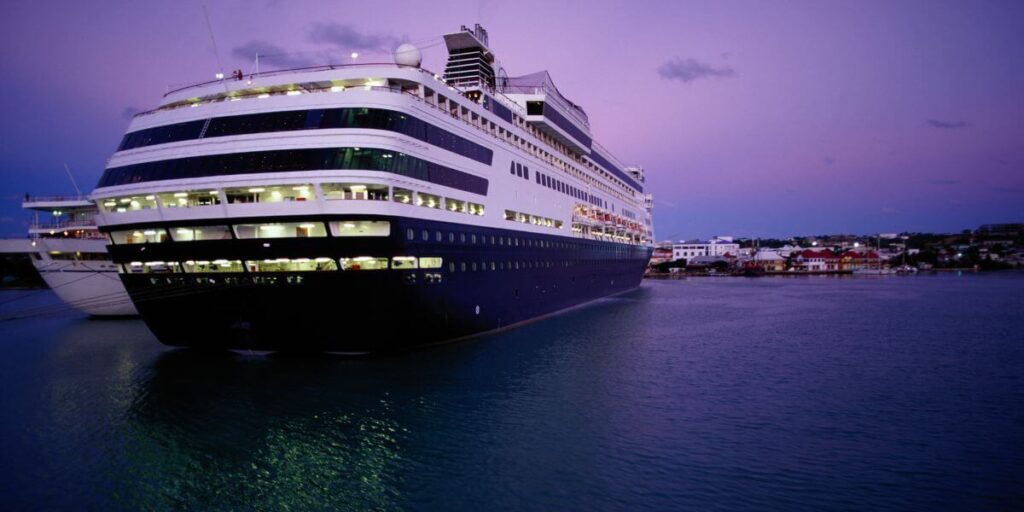While nobody wants to think about dying on vacation, it is the unfortunate truth that sometimes it happens. There are millions of cruise passengers every year, so it’s sadly inevitable that a small number will pass away while on their voyage.
And, of course, this isn’t like a land holiday where the body can be taken to a local morgue. Sometimes, passengers will die in the middle of the ocean, far away from any funeral home.

In those situations, what happens to a dead body on a cruise ship? Let’s take a look…
People die on cruise ships all the time…
When a cruise ship passenger dies, the staff places the body in the onboard morgue until the ship reaches a suitable port to disembark it, where it will be flown home. The cruise line will inform the next of kin if they’re not already sailing with the passenger.
The key point here is a ‘suitable’ port, as it needs to be somewhere that is willing and able to inspect the body, provide a death certificate and then process the task of flying the body back to the passenger’s home country.
A lot of ports aren’t suitable and would refuse to accept a body, so often a passenger who has passed away will remain on the ship for up to a week until the ship returns to a suitable location.
Once an appropriate port is found, the body will usually be disembarked from the ship in the early hours of the morning, one of the first things to happen once the ship has docked. This is to minimise the number of guests that see the body and potentially be upset.
It’s worth noting that while the cruise line will work with the port to arrange for the transfer of the dead body, including repatriation to the passenger’s home country, it won’t pay for it. That responsibility falls on the family of the passenger.
A lot of travel insurance plans will cover repatriation costs, but not all. But this is another example of why insurance is a must on a cruise holiday.
Cruise lines will also often employ dedicated staff to assist the on-board family of someone who has passed away. They are not usually trained counsellors, but they are available for support of administrative matters such as arranging the repatriation of the body and contacting a funeral home.
Some cruise lines will also take this a little bit further, by offering free phone and internet access to those families to help them make arrangements, and escorting them to a local hotel when they disembark.
If the cruise has a religious leader such as a priest on board, they may also be involved to offer support.
All cruise ships have morgues
All cruise ships are required to have morgue facilities where a body can be stored for up to a week. Staff are required to be trained in how to handle a passenger passing away, including the appropriate storage methods for a dead body to ensure it is kept secure.
Cruise ship morgues are located on a lower deck in an area inaccessible to passengers. This is usually next to the medical centre.
Morgues must be separate from any food storage locations for obvious hygiene reasons. But sometimes, food freezers may be nearby, as you can see from the photo below…
Cruise ship morgues have space for several bodies
A typical cruise morgue is able to hold at least three bodies, with an average capacity of three to six.
Larger ships will have a larger morgue to potentially hold multiple passengers or crew members, especially on longer sailings such as Transatlantic cruises or to destinations where repatriation isn’t possible.
There’s an urban legend mentioned on a few cruise websites that if cruise ships are doling out extra-large servings of ice cream, potentially for free, is a sign that the crew are trying to clear out a freezer space to store a body.
That is just a legend, though. Cruise ships have morgues, and body bags, and it would be a very exceptional case where more people passed away than the ship could accommodate. They would have backup plans in place that likely wouldn’t involve using food storage spaces.
Here’s what the morgue looks like on a cruise ship…
A cruise ship morgue is usually a simple room with one or two refrigeration units, with multiple compartments to hold a body. They don’t usually look like morgues you see on TV, with individual units for each body. The priority is simply storage until a suitable port is reached.
In the video below, you can see what the morgue looks like on Carnival Fantasy. This video was made after the ship was taken out of service. It is quite an eerie video, so I advise caution if you choose to watch it.
Understandably, there aren’t many videos of cruise ship morgues available online. They’re hardly something that cruise lines want to show off as part of a behind-the-scenes tour, and it would be unusual for cruise ship workers to film them.
However, this video does provide a quick glimpse at what a cruise ship morgue looks like. It’s a little shaky as a video, but you can see the unit with the slide-out shelves to store bodies.
You won’t be buried at sea
Whether you die on a ship or on land, cruise lines don’t offer a burial at sea. However, many do offer services that allow ashes to be scattered at sea. It varies by cruise line, but some offer dedicated ceremonies for this type of service.
When a passenger dies on a cruise ship, the family can’t request that the body is immediately buried at sea. Cruise ships don’t have the facilities to carry out the formalities of processing a body and providing a death certificate, which lists the cause of death. A body must always be stored until it can be disembarked at a suitable port for this service to be carried out.
But if you have a family member that you’ve already had cremated, and they were a fan of cruising or the sea in general, then it’s worth speaking to cruise lines to arrange a scattering of ashes, if that’s your wish.
Carnival Cruise Lines’ John Heald, a senior cruise director, has been quoted as saying that the trend for burials at sea is a fairly recent one (source), while the cruise line has confirmed that it now averages 200 complimentary ceremonies to scatter ashes every year.
While the service is free, travelling with the cruise line is not, so you would need to book a cruise as normal. You’d also need to make sure that the ashes were brought on board in a biodegradable urn that is completely sealed.
You would then pass the urn to the Guest Services team on board who would carry out the service for you – you don’t just get to pick and choose a location on the ship to do it. You would likely be able to attend, but expect the service to happen at a discreet time and place, away from other guests.
Once the ceremony has been carried out, you would normally receive a signed letter from the captain with the coordinates of where the ceremony took place.
The Bottom Line
Cruise ships are well prepared for any eventually during a voyage, including the untimely passing away of passengers. They have the storage facilities to hold a body safely and respectfully and will support the family of a lost loved one as much as possible.
It’s something you hope to never have to deal with during your cruise holiday, but at least you can have peace of mind that there is help and support available if someone in your party did pass away, so you wouldn’t be left wondering what you were supposed to do.
Related Posts:
- How Many Cruise Ships Have Sunk?
- What Happens If A Cruise Ship Is Hit By A Rogue Wave?
- Cruise Industry Statistics

Jenni Fielding is the founder of Cruise Mummy. She has worked in the cruise industry since 2015 and has taken over 30 cruises. Now, she helps over 1 million people per month to plan their perfect cruise holidays.


